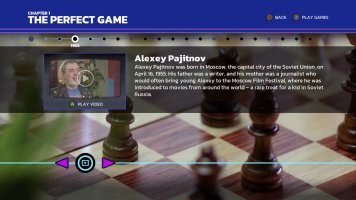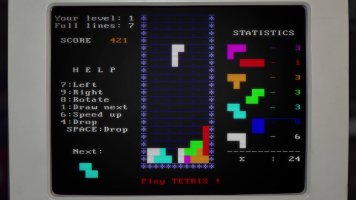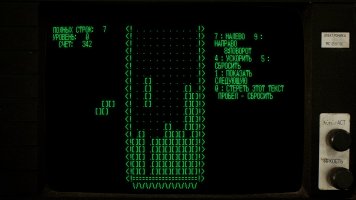Official Review
So, Tetris. Many call it the best game ever, thanks to its easy-to-play nature and lasting appeal. But we bet you might not know much about its beginnings, launch, and spread across the gaming world.
Enter Tetris Forever. Made by Digital Eclipse, it's the third in their Gold Master Series, diving deep into how this gaming icon came to be. If you've seen the earlier Gold Master releases (about Karateka and Jeff Minter), you'll know what to expect. It's full of talks, pictures, papers, and old stuff spread across five different timelines.
Plus, as we said before, Tetris Forever has 18 playable games. These range from a remake of the earliest Tetris on the Electronika 60 to Tetris Time Warp, a new take on the classic that Digital Eclipse made just for this package. It takes you through the game's history. It's a big release, and while the game selection is just a small part of all Tetris games ever made, the timelines make up for it by mentioning most major releases.
Speaking of which, Nintendo fans will find the timelines really interesting. If you know a bit about Tetris history, you'll know that a big part of its success came from being included with the Game Boy in the West. Tetris Forever digs into this story deeply, showing the back-and-forth fight to get the rights to the game, visits to NCL's offices, and of course, a big meeting between Nintendo's boss Hiroshi Yamauchi, Tetris maker Alexey Pajitnov, and licensing expert Henk Rogers.
Pajitnov and Rogers are the core of Tetris Forever. Their teamwork, bond, and care for the Tetris brand shape the story told in the five timelines. Pajitnov's creation of the game is especially interesting, starting with his love for pentomino puzzles where you fit different shapes into a box. By focusing on four-piece shapes and turning it into a video game, Tetris was born.
The story then covers Tetris's first release, Tengen's failed try to copy Nintendo's NES version, the many sequels and spin-offs that came after, and the start of Tetris Inc. and its work on the recent Tetris movie. It's thorough, and if you like the videos in Digital Eclipse's Gold Master Series, you'll love this one; there are lots of them, and it's great to watch Pajitnov and Rogers show such love for their work on the game.
For the playable games, Tetris Forever mostly avoids titles from the 2000s and later, when companies like Ubisoft, Sega, THQ, and EA started making Tetris games. Instead, it focuses on early versions of the main game and some less-known direct sequels. Amazingly, Digital Eclipse has remade Pajitnov's original Electronika 60 version of Tetris, with both Russian and English versions, green and white color options, and a cool Electronika 60-style border.
Then we have versions from MS-DOS, Apple II, and Famicom before moving to sequels like Hatris, Tetris 2 + Bombliss, the Japan-only Tetris Battle Gaiden, and Super Bombliss DX. Sure, the differences between many of these versions are small at times, but it's nice to see how the first publisher, Bullet-Proof Software, tried to grow Tetris and add variety for players over the years.
While mostly smooth, a few minor hiccups emerge. One such issue is the occasional inaccuracy in game control guides. For instance, the Electronika 60 version mistakenly lists 'A' for tetromino rotation when it's actually 'B'. It's a small oversight, likely to be addressed in a future update, but worth noting. Another slight inconvenience is the lack of standardized controls across games by default. When switching between titles, you'll need to either adapt to new controls or customize button functions for each game to ensure a seamless experience.
On the brighter side, the collection's standout feature is the brand-new Tetris Time Warp. This innovative addition offers a fresh take on classic Tetris gameplay while introducing visual variety. The concept is simple yet engaging: clear lines as usual, but occasionally, a special tetromino appears. Clearing this piece transports you to a different Tetris version for a limited time.
For example, you might find yourself in the '1989 version' (essentially the Game Boy release without official branding), tasked with clearing a double line in seconds. Or you could land in a Bombliss level, where your goal is to detonate a large bomb. Successfully completing these challenges propels you to another time period, allowing for rapid score increases if you chain several successes.
Time Warp also offers variations for those seeking a more traditional experience. Marathon mode lets you play standard Tetris without time warps, while '1989 marathon' provides the same gameplay with nostalgic Game Boy visuals. Multiplayer mode adds another layer of excitement, allowing players to weaponize different time periods against opponents, forcing them to tackle new challenges while you continue clearing lines on the main screen. It's an incredibly fun twist on the classic formula.
Conclusion
While Tetris Forever may not be the definitive chronicle of Tetris's entire history, it stands as the most comprehensive exploration of the franchise's creation and evolution to date. Digital Eclipse has truly mastered the art of interactive documentaries, packing this one with fascinating videos, interviews, and archival material. Although the playable game selection might not represent the broadest spectrum of the Tetris franchise, it offers a solid array of titles. The addition of Tetris Time Warp is a fantastic new entry to an already impressive catalogue that seems to keep expanding.
The collection showcases Digital Eclipse's commitment to preserving gaming history while introducing fresh elements to keep the experience engaging for both longtime fans and newcomers. By blending classic gameplay with innovative twists, Tetris Forever manages to capture the essence of what makes Tetris a timeless classic while pushing the boundaries of what's possible within the franchise.





